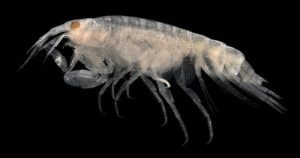 Mysteries
Mysteries  Mysteries
Mysteries  History
History 10 Surprising Stories About the Texas Rangers
 Humans
Humans 10 Philosophers Who Were Driven Mad by Their Own Theories
 Miscellaneous
Miscellaneous 10 Video-Game-Worthy Weapons and Armors from History
 Weird Stuff
Weird Stuff 10 Psychics Who Accurately Predicted Wartime Events
 The Arts
The Arts 10 Pieces of Art Inspired by a Broken Heart
 Health
Health 10 Science Fiction-Sounding New Medical Treatments
 History
History 10 Surprising Facts About the Father of Submarine Warfare
 Space
Space Ten Astonishing New Insights into Alien Worlds
 Weird Stuff
Weird Stuff 10 Bizarre Summer Solstice Rituals Still Practiced Today
 Mysteries
Mysteries Top 10 Haunting Facts About the Ghost Ship MV Alta
 History
History 10 Surprising Stories About the Texas Rangers
 Humans
Humans 10 Philosophers Who Were Driven Mad by Their Own Theories
Who's Behind Listverse?

Jamie Frater
Head Editor
Jamie founded Listverse due to an insatiable desire to share fascinating, obscure, and bizarre facts. He has been a guest speaker on numerous national radio and television stations and is a five time published author.
More About Us Miscellaneous
Miscellaneous 10 Video-Game-Worthy Weapons and Armors from History
 Weird Stuff
Weird Stuff 10 Psychics Who Accurately Predicted Wartime Events
 The Arts
The Arts 10 Pieces of Art Inspired by a Broken Heart
 Health
Health 10 Science Fiction-Sounding New Medical Treatments
 History
History 10 Surprising Facts About the Father of Submarine Warfare
 Space
Space Ten Astonishing New Insights into Alien Worlds
 Weird Stuff
Weird Stuff 10 Bizarre Summer Solstice Rituals Still Practiced Today
10 Unusual Animals Named after Famous People
While celebrities may be glamorous, the animals that bear their moniker are somewhat less so, as recently discovered creatures tend to be on the smaller side, like insects and bugs. The best that today’s famous faces can hope for is possibly a reptile found in a newly explored location or, at worst, some sort of oceanic blood-sucker.
Some celebrities have inspired numerous scientists and researchers with their appearance or a specific role, meaning they have more than one creature named in their honor.
When famous names are involved, it can shed some light on amazing species that may not be heard about otherwise. In fact, finding just one new species can involve years of hard labor in places that are challenging to explore, like the mountains or the ocean.
This is why there may be no greater compliment than having an animal named after you, even if it is a type of parasitic wasp.
Related: Top 10 Species that Shouldn’t Exist
10 The Harrison Ford Spider, Snake, and Ant
A species of snake found in Peru was named Tachymenoides harrisonfordi after actor Harrison Ford in recognition of his environmental advocacy as the vice chair of Conservation International. Harrison Ford is famous for his role as Indiana Jones and his iconic character’s fear of snakes. However, he still appreciated the honor and called it “humbling.”
The snake was discovered in the Andes mountain range, but it is harmless to humans and only measures about 16 inches (40.6 centimeters) when fully grown. Researchers hoped to highlight the importance of protecting new species of reptiles during the ongoing biodiversity crisis, as they are particularly vulnerable to extinction. Over one-fifth of the world’s reptile species are currently under threat.
Ford also has an ant called Pheidole harrisonfordi and a Californian spider, Calponia harrisonfordi, named after him.[1]
9 The Beyoncé Horse Fly
Pop singer Beyoncé has received the honor of having a horse fly named after her: Scaptia beyonceae. It was discovered in Northern Queensland, Australia, and officially named by researcher Brian Lessard from the Commonwealth Scientific and Industrial Research Organisation (CSIRO).
This fly, treated as a pest in the region, was collected in 1981, the same year of Beyoncé’s birth. It was named due to its unique golden-haired abdomen, which was said to resemble her hair. Researchers hope that this new name might discourage locals from swatting the fly.[2]
8 The Lady Gaga Wasp
A parasitoid wasp species from Chae Son National Park in Thailand was found and named after the singer Lady Gaga, whose real name is Stefani Joanne Angelina Germanotta. The species was discovered during a “turbo-taxonomic” study that utilized rapid genetic analysis to quickly name specimens in the country that had been gathered and barcoded.
This innovative approach was applied to 179 species of the Aleiodes genus, including the newly named Lady Gaga wasp— the Aleiodes gaga. This single female was found along a nature trail and measures only 5mm, but not much is known about it.
The study, led by Dr Buntika Areekul Butcher from Chulalongkorn University, aimed to speed up species discovery and was based on a three-year survey of Thai national parks. It contributed to the ongoing exploration of DNA’s role in identifying new creatures in tropical regions like Thailand, which have many unnamed species.[3]
7 The Donald Trump Burrowing Amphibian and Moth
A small moth, Neopalpa donaldtrumpi, was named after Donald Trump immediately before he became the 45th president of the United States. The moth was discovered in California by researcher Vazrick Nazari from Ottawa, Canada. He was inspired by the golden flakes on its head, which he thought resembled Trump’s distinctive hairstyle.
The moth’s habitat spans southern California and the Mexican region of Baja California, which raised questions about the potential impact of Trump’s proposed wall on local wildlife at the time. Nazari expressed hope that the naming would encourage Trump to prioritize environmental conservation and, in particular, safeguard the delicate ecosystems that still harbor numerous undiscovered species.
The year afterward, a blind and burrowing amphibian found in Panama was named Dermophis donaldtrumpi during Donald Trump’s presidency. The name was chosen by Aidan Bell, the CEO of EnviroBuild, a sustainable building materials company, who paid $25,000 at an auction for the naming rights.
Bell explained at the time that the creature’s behavior of burying its head in the ground was like Trump’s approach to climate change. The amphibian is particularly vulnerable to the impacts of global warming, and its naming is intended to draw attention to the dangers of it. The Rainforest Trust, which received the auction proceeds, chose to emphasize the importance of protecting rainforests to mitigate climate change in their comment on the decision.
This naming tradition follows the precedent of naming species after political figures, as exemplified by the numerous species named after President Barack Obama during his presidency, the next entry on this list.[4]
6 The Obama Menagerie
Scientists have immortalized former U.S. President Barack Obama in taxonomy by naming nine different species after him, surpassing the number for any of his predecessors. These species range from extinct lizards to trapdoor spiders and fish. Obama’s menagerie can be found all over the world.
Discovered in the U.S. is Aptostichus barackobamai, a trapdoor spider found in northern California named by biologist Jason Bond in appreciation of Obama’s statesmanship and resilience. Also in California is Caloplaca obamae, a firedot lichen that only grows on Santa Rosa Island, named for his support of science and education.
The Etheostoma obama is a spangled darter fish found in Tennessee named due to Obama’s focus on clean energy and environmental protection. Obamadon gracilis is an extinct insectivorous lizard discovered in Montana.
Tosanoides obama is a coral reef basslet fish that was discovered at the Papahānaumokuākea Marine National Monument and named after him due to his efforts in expanding the environmental protections for it. This endemic fish is just 2.4 inches (6.1 centimeters) long with a distinct pink, yellow, and blue coloration, as well as a red spot on the dorsal fin reminiscent of Obama’s campaign logo.
Over in Africa, Paragordius obamai is a hairworm parasite that was discovered in Kenya and named after Obama’s Kenyan heritage. Another fish is Teleogramma obamaorum, an African cichlid species named to recognize the Obamas’ commitment to science education and environmental conservation on the continent.
In Asia is the Baracktrema obamai, a turtle blood fluke found in Malaysian freshwater turtle’s lungs, symbolizing resilience and coolness, according to the biologist who named it. Finally is the Nystalus obamai, a western striolated puffbird that was named for Obama’s impact on green technology and ecosystem preservation.[5]
5 The Ruth Bader Ginsberg Mantis
Scientists from the Cleveland Museum of Natural History discovered a new species of praying mantis that they named Ilomantis ginsburgae in honor of Supreme Court Justice Ruth Bader Ginsburg.
The discovery process involved studying female mantis genitalia, a departure from the usual practice of studying males. It was an innovative approach by researcher Sydney Brannoch that resulted in identifying the new species. The choice of naming the mantis after Ginsburg was influenced by her advocacy for gender equality, as well as her distinctive frilly lace collars known as jabots.
The naming aimed to highlight the importance of considering both sexes in scientific investigations and pays tribute to Ginsburg’s efforts in extending constitutional rights and protections for women.[3]
4 The Bob Marley Crustacean Blood Feeder
A species of parasitic crustacean blood feeder, known as a gnathiid isopod, is named after the late Jamaican singer and guitarist Bob Marley. Gnathia marleyi was identified by researcher Paul Sikkel of Arkansas State University during a study of Caribbean coral reefs. Its name serves as a tribute to Bob Marley and his Caribbean heritage, and it was the first new species to be described in the Caribbean in over two decades.
Gnathia marleyi plays a unique ecological role as a blood parasite that feeds on reef fish. It is a species that highlights the potential impact of parasites on marine populations and the significance of understanding disease transmission in marine ecosystems. This is why it has been the subject of research funded by the National Science Foundation, which investigates the interplay between parasite-host relationships and the health of coral reef habitats.[7]
3 The Elton John Shrimp-Like Crustacean

In 2015, a new crustacean species that resembles a shrimp was found in the Indonesian reefs of Raja Ampat and called Leucothoe eltoni after the singer Elton John. It was named by researcher James Thomas from Florida’s Halmos College of Natural Sciences and Oceanography. The naming was a tribute to Elton John due to the researcher’s lifelong appreciation for his music.
The crustacean was discovered inside another reef invertebrate, a phenomenon known as “commensal association,” a type of parasitic relationship. Researchers in Hawaii also found that Leucothoe eltoni arrived in their seas as an invasive species.[8]
2 The Taylor Swift Millipede
A millipede species commonly found in the Appalachian Mountains has been renamed Nannaria swiftae in tribute to pop star Taylor Swift. This renaming was decided by entomologist Derek Hennen from Virginia Tech as a thank you to Swift, as her music helped him through graduate school. Millipedes are useful creatures in the Appalachians as they are essential for decomposition and nutrient distribution in wooded ecosystems.
However, millipedes like to hide beneath the soil surface, so they are surprisingly challenging to study. It took a multi-year project across 17 eastern U.S. states in order to discover 17 new millipede species, including Nannaria swiftae. The new set of creatures has distinctive features, such as white legs, red and orange spots, brown or black trunks, and unique front-leg claws in male Nannaria millipedes.[9]
1 The Bono Spider
Biologist Jason Bond from Auburn University has discovered and named 33 new species of trapdoor spiders, including three in Joshua Tree National Park in the California desert. Among these newly identified species, one has been named Aptostichus bonoi, paying tribute to U2’s frontman Bono. The renowned Joshua Tree was featured on U2’s 1987 album, also called The Joshua Tree.
This naming practice aligns with Bond’s previous choices, which include names inspired by Angelina Jolie, Cesar Chavez, and Stephen Colbert. Trapdoor spiders are found in the southwestern U.S. and are so-named because they create hatches to conceal themselves from prey as a survival strategy.[10]








